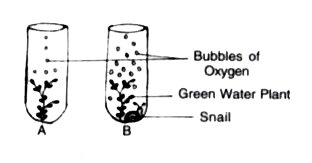If you take kerosene and water in a test tube, kerosene floats on water.
To solve the question of why kerosene floats on water in a test tube, we can break it down into the following steps:
Step 1: Understand the Concept of Density
Density is defined as mass per unit volume. It is a measure of how much mass is contained in a given volume. The formula for density is:
Density=MassVolume
Step 2: Identify the Densities of Kerosene and Water
From the information provided:
- The density of kerosene is 0.81g/cm3.
- The density of water is 1.0g/cm3.
Step 3: Compare the Densities
Now, we compare the densities of kerosene and water:
- Since 0.81g/cm3 (density of kerosene) is less than 1.0g/cm3 (density of water), we can conclude that kerosene is less dense than water.
Step 4: Apply the Principle of Buoyancy
According to the principle of buoyancy, an object will float in a fluid if its density is less than the density of the fluid. Since kerosene has a lower density than water, it will float on top of the water.
Step 5: Conclusion
Therefore, the statement that kerosene floats on water is true.
Final Answer
Kerosene floats on water because its density (0.81 g/cm³) is less than the density of water (1.0 g/cm³).
---
Density is defined as mass per unit volume. It is a measure of how much mass is contained in a given volume. The formula for density is:
Density=MassVolume
From the information provided:
- The density of kerosene is 0.81g/cm3.
- The density of water is 1.0g/cm3.
Now, we compare the densities of kerosene and water:
- Since 0.81g/cm3 (density of kerosene) is less than 1.0g/cm3 (density of water), we can conclude that kerosene is less dense than water.
According to the principle of buoyancy, an object will float in a fluid if its density is less than the density of the fluid. Since kerosene has a lower density than water, it will float on top of the water.
Therefore, the statement that kerosene floats on water is true.
Kerosene floats on water because its density (0.81 g/cm³) is less than the density of water (1.0 g/cm³).
Topper's Solved these Questions
- PHYSICAL QUANTITIES AND MEASUREMENTBOOK - ICSECHAPTER - PHYSICAL QUANTITIES AND MEASUREMENTEXERCISE - EXERCISE (SECTION II) F. Distinguish between the following
6 Videos
- PHYSICAL QUANTITIES AND MEASUREMENTBOOK - ICSECHAPTER - PHYSICAL QUANTITIES AND MEASUREMENTEXERCISE - EXERCISE (SECTION II) G. Short answer questions.
4 Videos
- PHYSICAL QUANTITIES AND MEASUREMENTBOOK - ICSECHAPTER - PHYSICAL QUANTITIES AND MEASUREMENTEXERCISE - EXERCISE (SECTION I) D. Choose the correct option to fill in the blank.
5 Videos
- MOTIONBOOK - ICSECHAPTER - MOTIONEXERCISE - TEST YOURSELF (NUMERICAL)
13 Videos
- SOUNDBOOK - ICSECHAPTER - SOUNDEXERCISE - EXERCISES (PICTURE STUDY)
4 Videos
Similar Questions
Give reasons : Ice floats on water.
View SolutionIce floats on water because
View SolutionKerosene and water can be separated by filtration.
View SolutionKerosene is denser than water.
View SolutionAn ice cube of side 1cm is floating at the interface of kerosene and water in a beaker of base area 10cm2. The level of kerosene is just covering the top surface of the ice cube.
a. Find the depth of submergence in the kerosene and that in the water.
b. Find the change in the total level of the liquid when the whole ice melts into water.

View SolutionA piece of iron sinks in water, but a slip made of iron floats in water. Why?
View SolutionIce floats in water but sinks in kerosene. Why?
View SolutionWhy an iron needle sinks in water, but an iron ship floats in water?
View SolutionWhen you put a steel pin in water it sinks, but a ship made of steel floats. WHY ?
View SolutionThe diagram below shows two test-tubos A and B. Test-tube A contains a green water plant Test-tube B contains both a groen water plant and a snail. Both test tubes are kept n sunlight Answer the questions that follow

Give an example of a water plant that can be used in the above experiment.
View Solution
